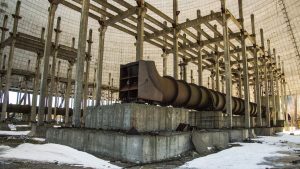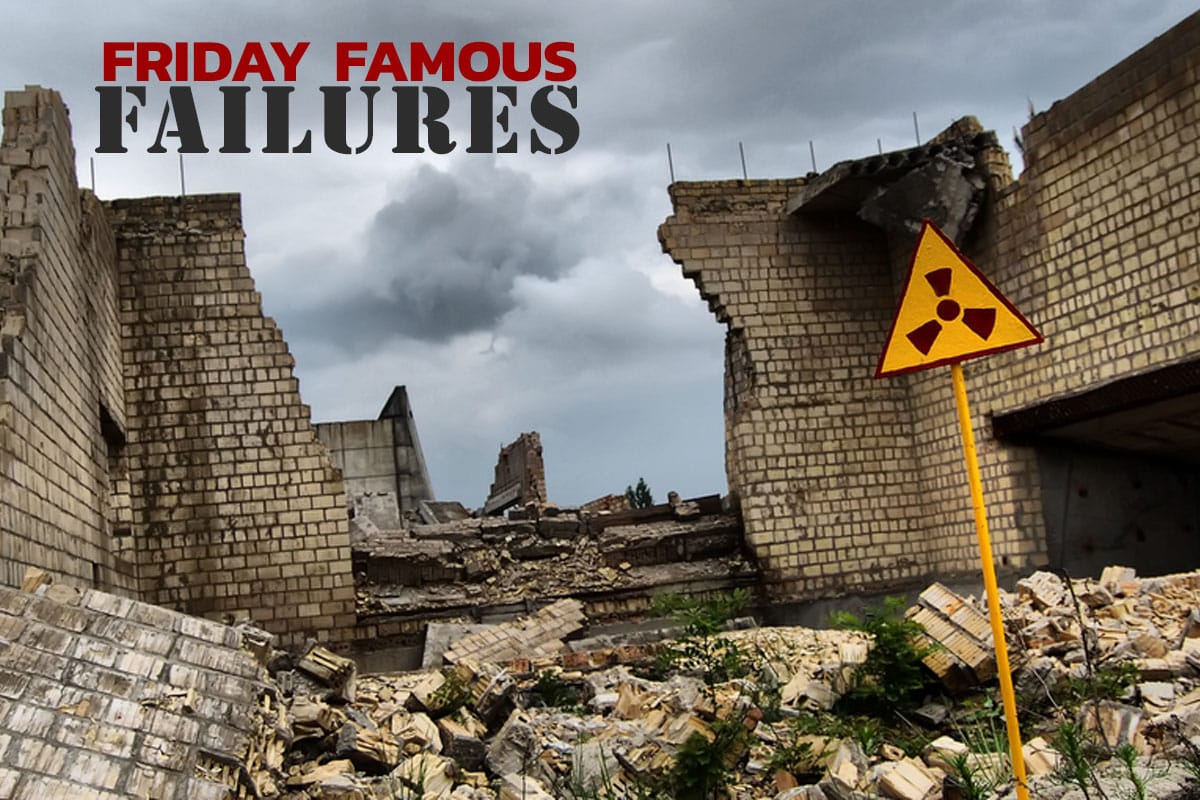The town of Pripyat in the Soviet Socialist Republic of Ukraine was new, pleasant and boasted both prosperity and job security as the location of the advanced, modern Chernobyl Nuclear Power Plant. Yet in April 1986, a reactor explosion killed many workers, caused lingering, painful illness and early death in others, and forced the evacuation of the entire town—and subsequently, a large zone around the power plant. To this day, the Chernobyl disaster is considered the worst nuclear accident in history.
Construction of the Chernobyl Nuclear Power Plant began in 1970. Simultaneously, ground was cleared to build the nearby city of Pripyat, Ukraine, which would house power plant workers and their families. The plant was completed when Reactor 4 was completed in 1983.
Reactor 4 Safety Test
On April 25, 1986, the crew of Reactor 4 prepared to perform a safety test of how long the steam turbines would spin and—using the residual rotational energy—continue to power the main water coolant pumps in the event of power loss. A similar test had been attempted the year prior, but it showed that the residual energy in the turbine did not power the coolant pumps long enough to safely cool the reactor. This test would evaluate new voltage regulator designs.
Anatoly Dyatlov, the Deputy Chief Engineer for Operations at the Chernobyl Atomic Energy station, came to Chernobyl from a top-secret assignment overseeing installation of reactors in the USSR’s nuclear-powered submarines. Dyatlov was by reputation arrogant and domineering toward the operators at Chernobyl. Dyatlov was to direct the safety test on Reactor No. 4, but by the time the test began, he was sleep-deprived and ill-tempered.
The young reactor engineer Leonid Toptunov was a rising star in nuclear power. A graduate of the Moscow Engineering and Physics Institute, Toptunov was only 25 years old the night he took over the controls of Reactor No. 4. Although very bright, Toptunov had only been a senior reactor operator for two months and had never directed the reactor through the challenging “normal shutdown” process (which was required by the test). During the shutdown, Toptunov skipped a step in the process, inadvertently allowing the reactor power output to fall too low. Observing this condition, Toptunov requested to shut down the reactor in accordance with normal procedures, but Dyatlov threatened Toptunov and ordered him to increase the reactor’s power back to the level prescribed for the test.
This decision was disastrous, as increasing power in that condition made the reactor susceptible to “reactor runaway,” which can lead to a core meltdown or explosion. At the end of the 36-second test, Toptunov pressed the emergency shutdown button, flooding the core with water (which was intended to rapidly cool the core and arrest the nuclear reaction). However, the reactor fuel had overheated during the long period at low power, causing much of the cooling water to flash into steam upon contact with the hot fuel. The result was a steam explosion that blew the concrete lid off the reactor, destroyed the roof and the upper portion of the reactor building, and vented the continuing nuclear reaction to the open air.
The Chernobyl fire department responded quickly to the fire at reactor number 4, although they had no radiation suits, respirators or working dosimeters. Miraculously, only two of the firemen died from acute radiation sickness shortly after the disaster, though others died in the following months and years and are listed as casualties of the Chernobyl Disaster.

Not until two days after the accident, at 11:00 on April 27, did buses arrive to evacuate the nearby town of Pripyat. Around 53,000 people were evacuated to various villages in the Kyiv region. Following the accident, teams of workers cleaned up the radioactivity at the site. Roughly 200,000 people from across the Soviet Union were involved in the recovery and cleanup between 1986 and 1987.
After the accident, a sarcophagus of concrete encased the reactor building. This temporary covering was intended to last 30 years, but in 2013 a section of the roof collapsed. In 1997, the international Chernobyl Shelter Fund began designing a permanent cover. The New Safe Confinement, made of steel, was placed over the concrete sarcophagus in 2016.
The Long-Lasting Impact
The impacts of the accident at Chernobyl are both wide-reaching and long-lasting. The accident resulted in the world’s largest uncontrolled release of radioactive materials and radiation ever recorded for a civilian operation. The fire continued for 10 days, emitting a dense smoke of radioactive particles high into the air. Wind and weather patterns scattered the radioactive debris across the wide areas of Ukraine, Russia and Belarus. Estimates indicate Chernobyl released 400 times more radioactive material than the atomic bombing of Hiroshima and Nagasaki. Reactors in Sweden, France, and England detected elevated radiation levels. A pine forest directly downwind of hot reactor turned reddish brown and died, earning the nickname “The Red Forest.” Hundreds of animals in nearby farms were born with deformities, like missing or extra limbs, missing heads or ribs, and deformed skulls. The Chernobyl Exclusion Zone was declared after the accident and still exists on the outskirts of Kyiv, the largest city in Ukraine.
Two power plant workers died immediately, 30 other operators and firemen perished within three months. Acute radiation syndrome (ARS) was diagnosed in 237 people and confirmed in 134 cases. The full human death toll of Chernobyl is difficult to estimate, as the long-term hazard of exposure to radioactive materials causes accumulation in vital organs such as the heart and within bones, and likely causes increased risk of cancer years after the event.
Initial investigations attributed the accident to operator mistakes during the test. The International Atomic Energy Agency’s (IAEA’s) 1993 revised analysis, however, blamed the reactor design and deficient safety features, most notably the “positive scram” effect of the reactor which caused increased reactivity when control rods were fully inserted to the reactor under certain conditions. Yet the IAEA still cited human error as a major cause of the accident, commenting, “most reprehensibly, unapproved changes in the test procedure were deliberately made on the spot, although the plant was known to be in a very different condition from that intended for the test.” The analysis also condemned the absence of a safety culture noting lack of planning for the design, engineering, construction, and operation of a power plant (seen by the poor quality of operating procedures and instructions).
In direct response to the Chernobyl disaster, the IAEA convened a conference in 1986 to create a Convention on Early Notification of a Nuclear Accident. The resulting treaty ensures signing members provide public notification of any nuclear and radiation accidents. In Italy, the disaster prompted a 1987 referendum to phase out nuclear power plants in 1988. In Germany, the disaster led to the creation of a federal environmental ministry. Significant advances in nuclear power safety resulted from investigation of the Chernobyl disaster. However, public faith in nuclear power eroded beyond repair and many countries have abandoned their nuclear programs.








The Chernobyl accident was highlighted in the US after the explosion, which could have ended nuclear power in the US altogether. However, there were many scientists and plant operators that knew the types of reactors used in the US were of a much safer design than the RBMK (high–power channel reactor). This design used water for cooling as in the US, but it also allowed for more steam production and higher power. The steam was produced in the core using a “positive void coefficient.” This meant the steam bubbles that formed occupied more space in the core channels where the fission heat was concentrated. Graphite was used as a moderator which helped in the absorption of neutrons (high energy particles produced in fission) to control the reactivity and the heat.
An example would be, if one took a pot of water and set it on a stove and turned the heat on high, it would eventually boil and the high-heat boiling would cause the water to splash out of the pot. In a low boil situation, one could observe the bubbles form on the bottom of the pot and then disappear after they started moving towards the top. In nuclear physics this is called the departure from nucleate boiling (DNB). It was determined in testing that is the maximum amount of heat that can be transferred into the water without the steam bubbles reaching the top of the pot and overflowing. Increasing the heat is achieved by increasing the pressure and temperature to maintain the DNB. This is where the term PWR (pressurized water reactor) got its name which is the main type of reactor in use around the world. The result of using a PWR is much safer control of the reactor in power ups and downs and emergencies.
The positive void coefficient used in a RBMK allowed operating the reactor with steam in the control rod channel which reduces power (steam does not transfer as much heat energy as does water). So the RBMK uses an ORM (operating reactivity margin) which is a dangerous operational tactic.
Fissions occur in nanoseconds or faster. Tremendous amounts of energy have to be controlled such that the reaction will continue to occur (chain-reaction), but not an out-of-control reaction (supercritical) and thereby keep the reactor operating normally. In PWRs, operators, technicians and scientists worked exceptionally well at maintaining reactor operations around the world.
Operating the RBMK reactor with the ORM in the right range requires diligent and extremely smart operators that can function in seconds for any excursion away from normality. The ORM was found to actually increase the reactivity during a shutdown as occurred at Chernobyl. The operators believing the reactor was going supercritical engulfed the hot reactor with cold water in an attempt to shutdown the core, but the water flashed instantly to steam causing an explosion and subsequent fire.
There are still 10 of the RBMK facilities still operating in Russia. There have been many upgrades to make them safer.